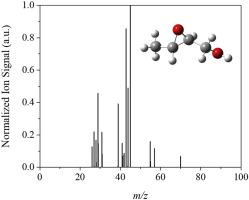当前位置:
X-MOL 学术
›
Int. J. Mass Spectrom.
›
论文详情
Our official English website, www.x-mol.net, welcomes your
feedback! (Note: you will need to create a separate account there.)
Fragmentation mechanisms from electron-impact of complex cyclic ethers formed in combustion
International Journal of Mass Spectrometry ( IF 1.6 ) Pub Date : 2020-08-01 , DOI: 10.1016/j.ijms.2020.116342 Alanna L. Koritzke , Kelsey M. Frandsen , Matthew G. Christianson , Jacob C. Davis , Anna C. Doner , Alexander Larsson , Josiah Breda-Nixon , Brandon Rotavera
International Journal of Mass Spectrometry ( IF 1.6 ) Pub Date : 2020-08-01 , DOI: 10.1016/j.ijms.2020.116342 Alanna L. Koritzke , Kelsey M. Frandsen , Matthew G. Christianson , Jacob C. Davis , Anna C. Doner , Alexander Larsson , Josiah Breda-Nixon , Brandon Rotavera

|
Abstract Cyclic ethers are important intermediates involved in degenerate chain-branching reactions during hydrocarbon and biofuel oxidation at temperatures below 1000 K. Depending on the molecular structure of the parent species, e.g. 1-butanol, butanone, or diethyl ether, cyclic ethers can include additional functional groups, such as an alcohol, carbonyl, or a second ether group. Electron-impact mass spectrometry (EI-MS) is a commonly used diagnostic to infer the molecular structure of cyclic ethers, and while mass spectra of simple cyclic ethers using EI are abundant in literature, measurements and related fragmentation patterns of complex cyclic ethers containing multiple functional groups are not, yet are important for determining the presence of species and inferring reaction mechanisms in combustion. The measurements in the present work provide reference EI mass spectra, which enable direct identification of cyclic ether species that are relevant to experimental chemical kinetics measurements of hydrocarbon and biofuel combustion. EI-MS measurements were conducted for 29 cyclic ethers with diverse functional groups such as alcohols, carbonyls, and alkyl substituents of varying length, 10 of which are reported for the first time: 2,3-epoxypentane, 3,4-epoxybutanol, (2-methyloxiranyl)methanol, 2,3-epoxybutanol, 1-(oxiran-2-yl)ethan-1-one, 3,4-epoxycyclohexene, 4,5-epoxycyclohexene, 2-methyloxetane, tetrahydrofuran-3-one, and 2-hydroxytetrahydrofuran. The objective of the present work is two-fold: (i) to provide reference measurements of EI mass spectra for complex combustion intermediates and (ii) to analyze fragmentation patterns of each species to assess the applicability of conventional mechanisms that are commonly employed for discerning molecular structure. The impetus for the latter objective is that, in the majority speciation experiments, EI mass spectra and fragmentation mechanisms are not reported, which raises open questions concerning the reliability of conventional mechanisms to define structural isomers of multi-functional cyclic ethers. In the present work, four conventional mechanisms were employed to analyze fragmentation patterns in the mass spectra: α-cleavage, inductive effect, hydrogen rearrangement, and transannular cleavage. The most common mechanism for the cyclic ethers was inductive cleavage, followed by α-cleavage or hydrogen rearrangement. Multi-functional cyclic ethers were more likely to undergo transannular cleavage occurring across the ring in a single step. For several species, however, abundant ion peaks in the mass spectra are not explained using conventional mechanisms. The present results highlight the importance of reference measurements of EI mass spectra for identifying complex molecules in speciation experiments, which is relevant given that ion fragments of the same mass-to-charge ratio (m/z) are common for species of the same mass.
中文翻译:

燃烧中形成的复杂环醚的电子作用的断裂机制
摘要 环醚是在低于 1000 K 的温度下烃和生物燃料氧化过程中参与简并链支化反应的重要中间体。根据母体物种(例如 1-丁醇、丁酮或乙醚)的分子结构,环醚可以包括额外的官能团,例如醇、羰基或第二个醚基团。电子轰击质谱 (EI-MS) 是推断环醚分子结构的常用诊断方法,虽然使用 EI 的简单环醚质谱在文献、测量值和包含多个复杂环醚的相关碎裂模式中非常丰富。官能团不是,但对于确定物质的存在和推断燃烧中的反应机制很重要。目前工作中的测量提供了参考 EI 质谱,它能够直接识别与碳氢化合物和生物燃料燃烧的实验化学动力学测量相关的环醚物种。对 29 种具有不同官能团(如醇、羰基和不同长度的烷基取代基)的环醚进行了 EI-MS 测量,其中 10 种是首次报道:2,3-环氧戊烷、3,4-环氧丁醇,( 2-甲基环氧乙烷基)甲醇、2,3-环氧丁醇、1-(环氧乙烷-2-基)乙烷-1-酮、3,4-环氧环己烯、4,5-环氧环己烯、2-甲基氧杂环丁烷、四氢呋喃-3-酮和2-羟基四氢呋喃。当前工作的目标有两个:(i) 为复杂燃烧中间体提供 EI 质谱的参考测量值和 (ii) 分析每个物种的碎片模式,以评估通常用于辨别分子结构的常规机制的适用性。后一个目标的推动力是,在大多数物种形成实验中,没有报告 EI 质谱和碎裂机制,这引发了关于定义多功能环醚结构异构体的常规机制的可靠性的开放性问题。在目前的工作中,采用四种传统机制来分析质谱中的碎片模式:α-裂解、诱导效应、氢重排和跨环裂解。环醚最常见的机制是感应裂解,然后是α-裂解或氢重排。多功能环醚更可能在一个步骤中发生跨环的跨环裂解。然而,对于一些物种,质谱中的大量离子峰无法使用传统机制进行解释。目前的结果强调了 EI 质谱的参考测量对于在物种形成实验中识别复杂分子的重要性,鉴于相同质荷比 (m/z) 的离子碎片对于相同质量的物种很常见,这是相关的.
更新日期:2020-08-01
中文翻译:

燃烧中形成的复杂环醚的电子作用的断裂机制
摘要 环醚是在低于 1000 K 的温度下烃和生物燃料氧化过程中参与简并链支化反应的重要中间体。根据母体物种(例如 1-丁醇、丁酮或乙醚)的分子结构,环醚可以包括额外的官能团,例如醇、羰基或第二个醚基团。电子轰击质谱 (EI-MS) 是推断环醚分子结构的常用诊断方法,虽然使用 EI 的简单环醚质谱在文献、测量值和包含多个复杂环醚的相关碎裂模式中非常丰富。官能团不是,但对于确定物质的存在和推断燃烧中的反应机制很重要。目前工作中的测量提供了参考 EI 质谱,它能够直接识别与碳氢化合物和生物燃料燃烧的实验化学动力学测量相关的环醚物种。对 29 种具有不同官能团(如醇、羰基和不同长度的烷基取代基)的环醚进行了 EI-MS 测量,其中 10 种是首次报道:2,3-环氧戊烷、3,4-环氧丁醇,( 2-甲基环氧乙烷基)甲醇、2,3-环氧丁醇、1-(环氧乙烷-2-基)乙烷-1-酮、3,4-环氧环己烯、4,5-环氧环己烯、2-甲基氧杂环丁烷、四氢呋喃-3-酮和2-羟基四氢呋喃。当前工作的目标有两个:(i) 为复杂燃烧中间体提供 EI 质谱的参考测量值和 (ii) 分析每个物种的碎片模式,以评估通常用于辨别分子结构的常规机制的适用性。后一个目标的推动力是,在大多数物种形成实验中,没有报告 EI 质谱和碎裂机制,这引发了关于定义多功能环醚结构异构体的常规机制的可靠性的开放性问题。在目前的工作中,采用四种传统机制来分析质谱中的碎片模式:α-裂解、诱导效应、氢重排和跨环裂解。环醚最常见的机制是感应裂解,然后是α-裂解或氢重排。多功能环醚更可能在一个步骤中发生跨环的跨环裂解。然而,对于一些物种,质谱中的大量离子峰无法使用传统机制进行解释。目前的结果强调了 EI 质谱的参考测量对于在物种形成实验中识别复杂分子的重要性,鉴于相同质荷比 (m/z) 的离子碎片对于相同质量的物种很常见,这是相关的.











































 京公网安备 11010802027423号
京公网安备 11010802027423号